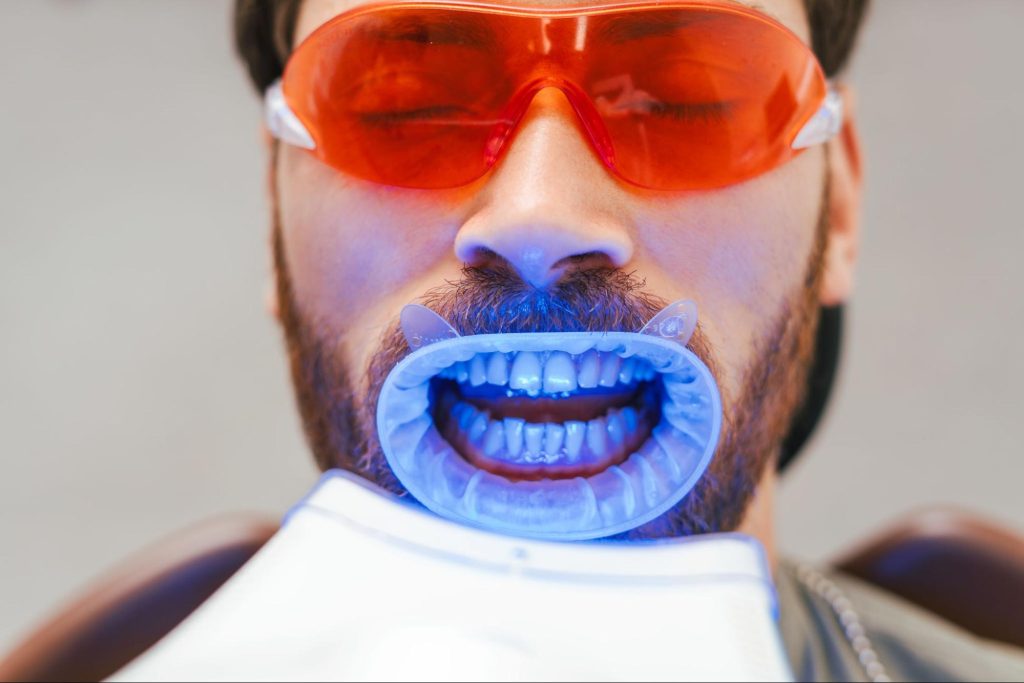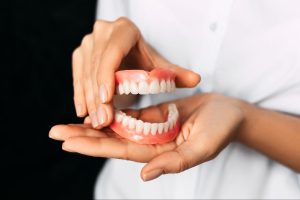Your smile makes a lasting impression—often before you say a word. But when teeth lose their brightness, confidence can fade just as quickly. Teeth whitening may seem straightforward, but a single mistake can lead to sensitivity, uneven results, or even permanent damage. Quick-fix kits promise speed but rarely deliver safety. That’s where your dentist steps in, turning guesswork into a safe, customized dental services plan that works.
Why Safe Teeth Whitening Plans Matter
Whitening your teeth should never be a gamble. Too many people trust random products without checking the risks. Whitening the wrong way can do more harm than good. You need a plan that protects your health and gets results.
Risks of Over-The-Counter Whitening Products
Store-bought whitening kits may seem convenient, but they can be risky. Many contain harsh ingredients that irritate gums and damage enamel. Without dentist supervision, it’s easy to overuse or apply them unevenly, leading to increased sensitivity or long-term harm. These products often skip safety standards and don’t factor in your oral condition.
Understanding Tooth Discoloration Before Treatment
Teeth can stain from coffee, wine, smoking, or even medications. Some stains sit on the surface, while others run deep inside. Whitening won’t work the same way for every type of stain. Treating the wrong kind without knowing the cause is a waste of time. Dentists identify the type of stain and the root cause before starting any whitening treatment.
How Dentists Build Safe Teeth Whitening Plans
Creating a whitening plan isn’t about guessing—it’s about knowing. Dentists use your dental history, condition, and goals to design a personalized treatment plan. This personalized approach helps avoid damage and yields brighter, more even results.
Initial Dental Assessment
Before whitening starts, your dentist checks your entire mouth. They look for issues like cavities, gum problems, or worn enamel. Whitening on top of dental issues can lead to severe sensitivity. You’ll also know what results to expect and how long it might take. This step builds the foundation for a safe whitening experience.
Matching the Right Whitening Method to the Patient
No two smiles are alike. Some benefit from in-office bleaching, while others respond better to take-home trays. Your dentist can choose a gentler formula if your teeth are already sensitive. The correct method depends on your enamel type, the type of stain, and your comfort level. A dentist can tailor the approach to your goals without compromising your teeth.
Custom Trays vs. One-Size Kits
Generic whitening trays don’t fit your teeth as well as they should. They often leak gel, which can irritate your gums or miss spots on your teeth. Custom trays made by your dentist solve that issue with a snug fit. They provide even results while avoiding over-bleaching and patchy spots. Custom trays also use safer, dentist-approved gels with better control.
Benefits of Dentist Care in Safe Teeth Whitening Plans
Professional whitening means better results and fewer risks. When a dentist manages your whitening, every step is adjusted to your needs. They’re trained to spot issues early and protect your oral health while you brighten your smile.
Supervised Whitening Means Safer Results
In-office whitening is carefully controlled from start to finish. Your dentist applies the gel, shields your gums, and watches for any issues. They use the right strength of bleaching agents for your situation. The result is a faster, safer, and more consistent outcome. You get expert support with minimal chance of damage or side effects.
Reduced Risk of Sensitivity and Damage
Whitening agents can make teeth feel sharp or painful. Without guidance, you might use a formula that is too strong or apply it too often. Dentists can adjust the product strength or apply special solutions to reduce discomfort. They keep your enamel protected during and after treatment. You get peace of mind knowing your teeth won’t suffer.

Reliable and Predictable Outcomes
DIY kits can leave some teeth too white while others remain stained. They don’t adapt to your mouth’s unique structure. Dentists create even, natural-looking brightness by tracking and adjusting your results when needed. They help avoid over-whitening, which can look fake or damage enamel. You’ll know what to expect and how to maintain your desired look.
Safe Teeth Whitening Plans for Special Cases
Not everyone can use whitening in the same way. Some people have dental work, age-related enamel changes, or different sensitivities. Dentists account for all these factors when they build your whitening plan.
Safe Teeth Whitening Plans With Dental Restorations
Teeth with fillings or crowns won’t respond to whitening like natural enamel. If you whiten the surrounding teeth, those restorations may look darker. Dentists adjust the shade plan or replace restorations for a balanced look. They know how to work around these issues without leaving visible contrast, keeping your smile clean and natural.
Teens, Seniors, and Sensitive Groups
Young people may not need whitening, and seniors may have deeper stains. Age also affects enamel thickness and gum recession, making whitening more complex. Dentists assess each patient’s age, enamel condition, and history. They avoid aggressive treatments in sensitive cases and adjust for safety, making professional whitening safer across age groups.
Whitening After Orthodontic Treatments
After removal, braces and clear aligners can reveal white spots or uneven color if proper oral hygiene wasn’t maintained during treatment. Whitening too soon can make those flaws stand out more. Dentists evaluate your enamel before deciding on the correct method. They often wait a few months after getting braces to allow for healing and the color to even out. That helps bring back a clean, balanced smile with minimal risk.
Maintaining Results With Safe Teeth Whitening Plans
Whitening isn’t permanent. Without the proper care, stains come back fast. Dentists help you maintain a bright smile with safe follow-ups and smart habits.
Dentist-Approved At-Home Care
After whitening, your dentist may recommend custom trays for touch-ups. They’ll guide you on when and how often to use them. Store-bought kits often fail to match the original treatment, resulting in uneven results. With dentist-approved products, you can maintain your brightness without compromising your enamel. You stay in control of the process long after your visit.
Foods, Habits, and Lifestyle Choices
Some foods stain teeth more than others. Red wine, dark berries, coffee, and smoking are common culprits. Your dentist will show you what to avoid, especially right after whitening. You don’t have to cut everything, but timing and moderation matter. Making wise choices helps your white smile last longer.
Regular Check-Ins Keep Your Smile Bright
Dentists don’t just whiten—they track your progress afterward. You’ll have regular cleanings and check-ups to spot changes early. They can adjust your maintenance plan if your teeth begin to stain again. That keeps your whitening from fading or becoming uneven. Consistency protects your results and avoids future problems.

How Enamel Health Affects Safe Teeth Whitening Plans
Your enamel isn’t just a protective layer; it determines how well whitening works. Bleaching products behave differently when enamel is thin, damaged, or worn down. Ignoring enamel health leads to poor results or painful sensitivity. Dentists first check the condition of the enamel to avoid causing more harm than good.
Why Enamel Thickness Matters Before Whitening
Enamel is the hardest substance in your body, but it wears down. The whitening gel can hit the dentin underneath if the enamel thickness is too thin. Dentin has a yellow tone and doesn’t bleach like enamel, so some people don’t see the expected results. Dentists check enamel thickness to avoid pushing products that won’t help or could hurt.
Signs of Enamel Damage Your Dentist Looks For
Not all enamel damage is evident. Dentists look for white spots, rough edges, or shiny wear on the chewing surfaces of teeth. These signs mean the enamel is breaking down or thinning. Whitening over damaged enamel can cause stinging, sharp pain, or uneven bleaching. A professional assessment helps identify and address these issues early on.
Adjusting Whitening Methods for Weak Enamel
If your enamel is weak, that doesn’t mean whitening is off the table. Dentists can use lower-strength gels or space-out treatments. They might add fluoride or desensitizers before and after whitening. This gentle approach protects your teeth while still providing gradual results. A personalized plan keeps things safe without sacrificing brightness.
The Science Behind Safe Teeth Whitening Plans
Understanding how whitening works helps you make better choices. It’s not just about applying gel and hoping for whiter teeth. There’s real chemistry involved, and your dentist uses it to guide the process. When whitening is rooted in science, it’s safer and more effective.
How Whitening Gels Break Down Stains
Whitening gels use either hydrogen peroxide or carbamide peroxide. These release oxygen molecules that penetrate the enamel and reach deep stains. They break the molecular bonds of stain compounds and lift them out. This process works over time and doesn’t scrape or erode enamel. That’s why dentists control the strength and exposure based on your needs.
Why Concentration Levels Need Professional Oversight
Too much peroxide can do more than irritate—it can burn your gums. High concentrations are only safe in short bursts with barriers in place. Lower doses are safer for at-home use but take longer to work. Dentists balance effectiveness with safety by choosing the right concentration. That’s a step no over-the-counter kit can handle with precision.
The Difference Between Whitening and Cleaning
Whitening removes stains inside the tooth surface while cleaning removes plaque, tartar, and surface stains on the outside. Many people confuse these two and expect whitening to fix buildup. Dentists clean your teeth first, so the whitening gel works better. That combo brings out the brightest version of your smile without shortcuts.
Start Safe Teeth Whitening Plans With the Right Expert
A brighter smile isn’t just about appearance; it’s about taking control of how you show up in the world. Whitening without guidance is like driving blind: you may move fast but not in the right direction. A trusted dentist doesn’t just whiten your teeth; they shape a path that’s safe, smart, and built around you. If you’ve waited for the right time to make your smile match your confidence, it’s now. Talk to a dental professional who knows your teeth and values your long-term health as much as you do.
Explore more expert tips and trusted dental advice on the Meader Family Dentistry blog —your smile deserves it.






